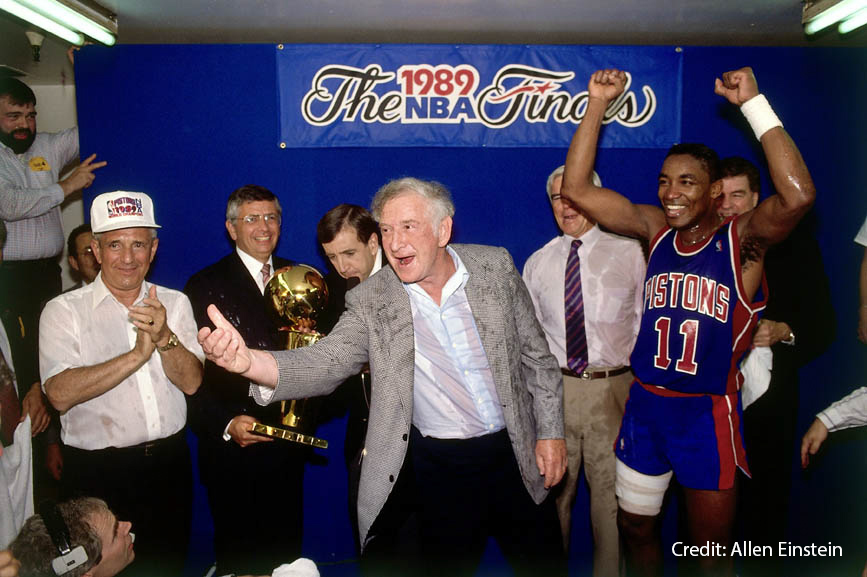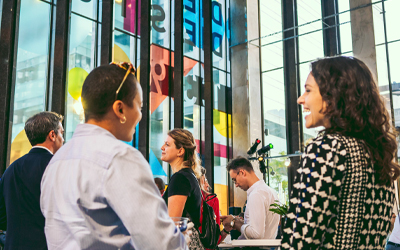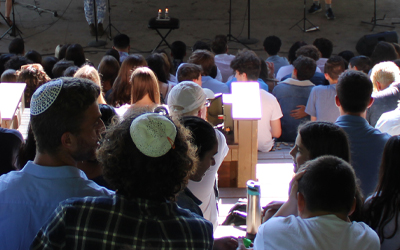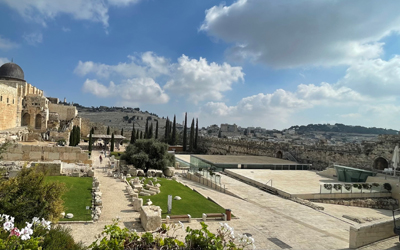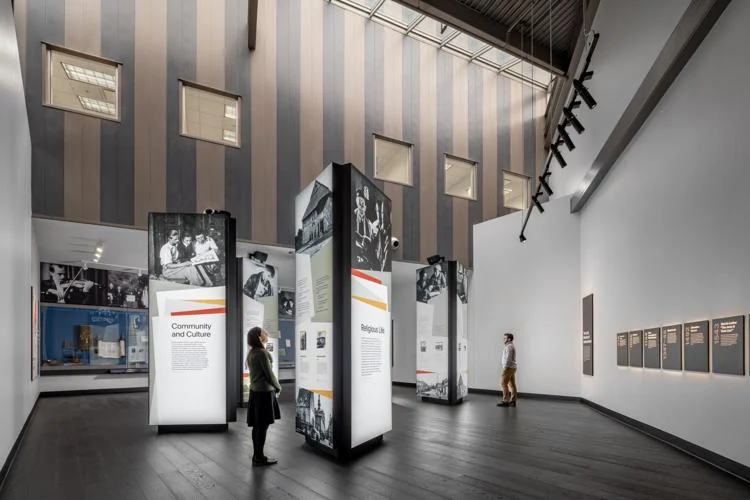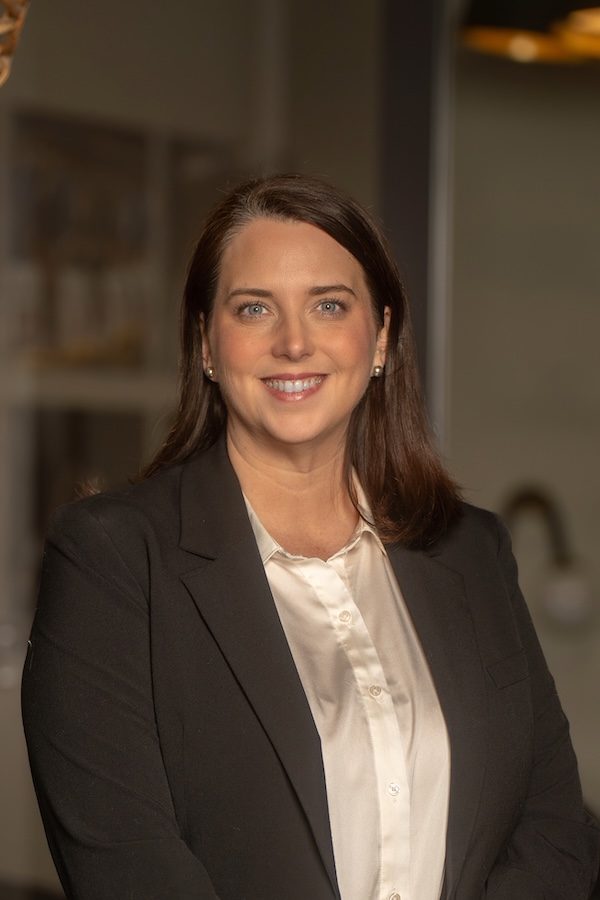Esther Allweiss Ingber Jan 18, 2024
The Holocaust Center’s newly renovated permanent exhibit places the emphasis on personal Jewish experiences.
On an early tour I took last month of the reimagined The Zekelman Holocaust Center (The HC), I was touched to find a panel in one gallery that showed my late father, Zyga “Zygie” Allweiss. I read a statement extracted from his own recorded testimony at the museum in which he shares a frightening experience he witnessed in a concentration camp.
The memories of Holocaust survivors like my dad, whether living or deceased, have been taken out of the museum vaults and brought front and center in an extensive reshaping of how The HC explains the Holocaust. We hear portions of the survivors’ testimonies in their own voices. We consider their words displayed on panels and gallery walls or projected on floors. Sometimes we realize we even know the people we are seeing and hearing. By shifting the focus from the perpetrators to the Jewish victims, The HC is preserving the legacy of our precious survivors to benefit generations to come.
The public will have its first official opportunity to explore the thoughtfully designed and more relevant The Zekelman Holocaust Center when its doors open at 9:30 a.m. Sunday, Jan. 28.
After World War II, Michigan was home to 4,000 Jewish Holocaust survivors, including Hidden Children and others who barely escaped the coming Nazi threat. The arrivals built forward-looking lives during decades of safety and security in the United States.
These special individuals evoke our respect for the losses they experienced and survived before joining our Michigan Jewish community.
Many of the Detroit-based residents found friendship in Shaarit Haplaytah (“The Remnant”). They actively supported the late Rabbi Charles H. Rosenzweig’s 20-year quest to build a museum dedicated to their experiences. The founders achieved their goal by 1981 on the grounds of the Jewish Community Center in West Bloomfield. When it opened officially in 1984, theirs was the first free-standing Holocaust museum in the United States.
Motivated survivors, including Zygie, joined elected officials and other dignitaries in 2001 for the groundbreaking of the current museum in Farmington Hills, which opened four years later. The Zekelman Holocaust Center, honoring a major donor family, became the museum’s new name two years ago in January.
After Rabbi Eli Mayerfeld became the chief executive officer about seven years ago, various stakeholders at The HC — including staff, volunteers, survivors, docents and board members — started working with him on a strategic plan to develop the museum’s priorities. One was updating the core exhibit from 2004.
As the survivor population dwindles, the planning group started thinking about how best to meet the needs of future museum visitors. Mayerfeld said the planners realized they had the ability to present the Holocaust story in a new way, one that would ensure the survivors’ voices were central.
“The decision to focus on Holocaust victims and survivors in the renovation is a truly unique approach for a Holocaust museum,” said Mark Mulder, director of curatorial affairs at The HC, who played a major role in the renovation. Each gallery topic encountered incorporates the first-person Jewish experiences of survivors, thereby adding context to visitors’ knowledge of the Holocaust.
“When we opened here 20 years ago, visitors would have met a survivor,” Mayerfeld said. “Your experience was flavored by an individual survivor telling his or her story.”
Now, the museum is designed so survivors’ stories are reflected in displays and through technology. Visitors have a new opportunity to “understand the history and tragedy of the Holocaust on a more personal and human level,” said Dr. Charles Silow, longtime director of the Program for Holocaust Survivors and Families, a service of Jewish Senior Life.
Making It Happen
The HC hired Ralph Appelbaum Associates (RAA) of New York City as its design partner for a nearly complete renovation of the museum’s educational component. Founded in 1978, RAA is an interdisciplinary creative studio dedicated to the planning and design of narrative environments.
Mayerfeld said RAA is renowned for its work at the U.S. Holocaust Memorial Museum in Washington, D.C., and other Holocaust museums, such as one in Houston that opened in 2019 and another museum in the design phase in Lithuania.
“RAA carried out the vision for what we were trying to accomplish,” Mayerfeld said. The $31 million investment in the renovation of the core exhibit is part of a larger $100 million comprehensive campaign to fund the center’s operations, grow the endowment and expand educational programming across the state. To date, more than 60 percent of the funds have been raised.
After renovating the museum’s core exhibit, “The Holocaust,” visitors will experience redesigned galleries reflecting the educational institution’s new orientation. The installation takes up 15,000 square feet of space on two levels of the building. Public tours stopped during the build phase that began in late May 2023, but The HC continued to present a series of public programs, events and temporary exhibits.
“Hours of discussion went into determining which items should be included to best meet the goals of our exhibit,” Mayerfeld said.
“We got into the weeds,” Mulder acknowledged, describing his collaborative relationship with RAA. He’d tell project manager Gabriel Ivorra and other principals from RAA his curatorial vision for the new exhibit, and they would come up with ideas. “I would respond, and we went back and forth.” Some decisions were small but powerful, such as whether to add a cracked pane for the Kristallnacht section.
“Each design choice you make has consequences,” Mayerfeld said. “Our big choice is the focus on the survivors’ testimonies,” referring to the museum’s extensive collection of recorded video interviews.
“We didn’t want to focus on the perpetrators, but rather how Jews reacted to their circumstances in whatever was happening next,” he said. “In ‘The Final Solution’ (a necessarily perpetrator-focused gallery), we let survivors talk about their own family being rounded up and subjected to more mistreatment.”
A display case I noticed while touring the museum shows the altered prison uniform of tailor Ben Guyer, a local survivor. Resourcefully, he added pockets to the jacket after liberation and wore it around his displaced persons camp.
Emphasizing Education
A team put together by Ruth Bergman, the museum’s director of education, handled research and writing.
“We wanted the educational approach to come through the exhibit, in the topics and language, to be consistent with the pedagogy of the museum,” Mayerfeld said. “We went back and forth to make sure every word was meaningful.”
Recognizing that parts of the Holocaust story were unique to women, one team member researched how frequently women’s stories were being told in testimonies in other Holocaust museums. Now, women survivors’ Holocaust experiences get more equal attention with men’s at The HC.
“What did women experience with regard to rape, forced brothels, having periods and needing supplies, pregnancy and abortion?” Bergman said of questions they researched. The new exhibit incorporates women’s stories as victims, she said, but also as partisans and couriers going in and out of ghettos, as well as their roles as armed resisters.
In a dark section about the death camps’ liberation, a film with captured images from the time shows respect for the victims. “We were careful about not presenting images of malnourished Jews with shaven heads in these places, knowing we never had their permission to show them. That’s a change of thinking from the past,” Mayerfeld said.
Instead of showing piles of shoes, suitcases and other items taken from Jews, the new exhibit highlights individual artifacts. The items were those discovered by liberators after the war or donated by survivor families. The HC welcomes more such items for the display because artifacts (and archival documents) will be rotated periodically.
“What makes artifacts come to life in the exhibit are the stories that go with them,” Mayerfeld said. Film clips projected behind spotlighted items show Jews before the war interacting with similar objects. A little girl plays gently with her doll in one clip, for example.
Mulder said he’s most proud of how Jewish life and culture are presented between the wars in the new “Jewish Heritage” gallery. “The education team came up with the brilliant idea of focusing on relatable subjects, such as home life, work or religious life. Within those topics we explore different types of experiences by using survivor testimony as a way of emphasizing that Jewish life was not a monolith.”
Bergman said it took her team more than 18 months to write content for the exhibit panels.
Because it is impossible to tell of the entire Holocaust, “we had to make some difficult choices about what we had to leave out,” she said. “It’s a huge responsibility.”
“We want to give people something to think about,” Bergman said of the chosen material in each gallery. In a section discussing Germany’s Nuremberg Laws, for example, “we see on one wall, law after law enacted year after year to constrict Jews’ lives and isolate them,” she said. “On the right side are quotes from survivors who remembered what it was like living under those laws.” Allowing survivors to tell how they were affected helps convey the impact of the laws on real people living at that time.
Many museums talk about the six Nazi death camps. “That’s important, but again, we wanted to focus on what that experience was like for those who went through the camps,” Bergman said. Panels list different aspects of life in the camps, from the perspective of the victims. “We are making sure visitors hear the voices of the survivors and the experience of the victims, not only the perpetrators.”
The exhibit’s introductory film features several local survivors. “We want the first and last word to be those of survivors,” Bergman said. “The questions we’re really asking is: Why should people learn about the Holocaust and want to come to our museum? We believe they can learn about tolerance, compassion and our survivors’ passion for life from them and feel their hope for the future. That’s very powerful. These were people who could have lost their faith in humanity but did not.”
The testimonies of five survivors featured in the gallery, “Michigan Survivors Reflect,” provide examples of resilience and also of how they rebuilt their lives after the war. Mulder said the flexible design of this, and other exhibits, will allow the stories to be changed out to keep them fresh and feature other survivors.
Toward the end of the tour is the section, “Responsibility,” featuring a video clip of the late Dr. Guy Stern. The beloved original director of the museum’s Harry and Wanda Zekelman Institute of the Righteous defines genocide and discusses recent instances worldwide. Then he asks a definitive question: “What can people do?” Viewers are challenged to consider ways in which they might feel more empowered now to prevent future atrocities.
The enlightening and often emotional experience of touring the museum is capped in the final gallery, one of the museum’s several new “reflection” spaces. Everyone is encouraged to write down thoughts of their museum experience on large blank cards. Posted to an expansive blank wall, the cards become a tapestry of messages in support of compassion, kindness and civic engagement. Exposure to Holocaust education, studies show, is likely to motivate people to challenge expressions of hate, prejudice and other damaging human behavior.
Previous visitors can be assured that the museum retains many familiar features. They include the Eternal Flame and Memorial Wall, the Henrietta and Alvin Weisberg Gallery with a Holocaust-era box car and the Viola and Garry Kappy Anne Frank Tree Exhibit and Garden.
“Our museum is different in that more than 80 percent of our visitors come through a guided tour, instead of individually,” Mayerfeld said. “We wanted an exhibit that would work with both groups.” When available, visitors of all ages can take a daily 1 p.m. tour led by a docent, with another 30 minutes at the end to hear one of the trained Next Generation volunteer speakers. They are the children and grandchildren of survivors.
Before my group tour, I was given a state-of-the art audio device. I thought it was a great upgrade. The units, with superior sound quality and a range of about 300 feet indoors, give tour-goers a chance to linger and explore galleries more at their own pace. Wearers are still able to hear their tour guide speaking in a nearby room. And now, teachers can more easily call their students back together.
School groups began touring the renewed museum in December.
“My biggest moments so far,” Mulder said, “are hearing students talk about how the exhibit is about people as much as it is about this larger historical event.”
Expanding Role for Portraits of Honor
Of growing importance in the museum’s refocus is “Portraits of Honor: Our Michigan Holocaust Survivors.” The interactive Holocaust education project is a presentation of the Program for Holocaust Survivors and Families of Jewish Senior Life, CHAIM (Children of Holocaust-survivors Association in Michigan) as well as The Zekelman Holocaust Center.
Plans are being formulated for expanded on-site access to portraitsofhonor.org, which features a searchable database of Michigan-based survivors and Holocaust-era experiences. Meanwhile, the project’s signature collection of black-and-white framed portraits of Holocaust survivors, 750 in all, continue to line the walls of three museum classrooms. Additional participants are welcome.
Grand Opening Jan. 28
The grand opening of the new permanent exhibition at The Zekelman Holocaust Center will be from 9:30 a.m.-4:30 p.m. Sunday, Jan. 28, in observance of International Holocaust Remembrance Day. Admission is free.
A dedication ceremony will be at 11 a.m. At noon, local Holocaust survivor Irene Miller will share her life story. Also scheduled are “Conversation with the Curator and Designer” at 1:30 p.m. and “Spotlight on Women in the Holocaust” at 2:30 p.m.
The Zekelman Holocaust Center is at 28123 Orchard Lake Road in Farmington Hills. For details, visit holocaustcenter.org or call (248) 553-2400, ext. 140.

